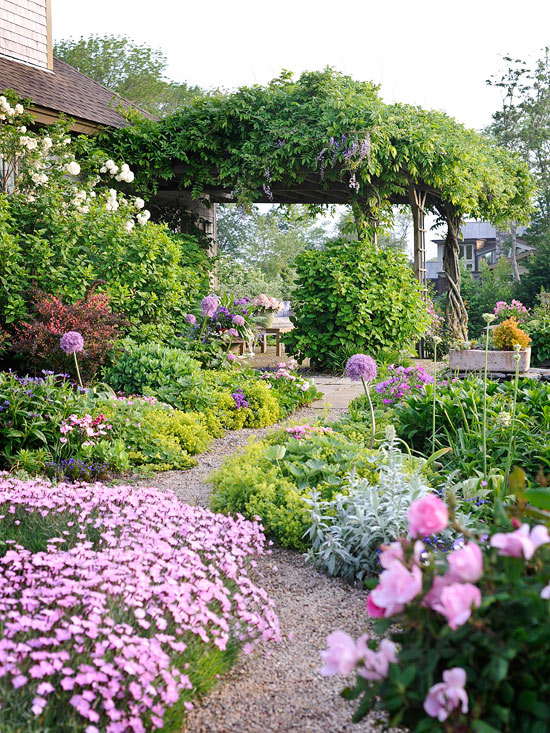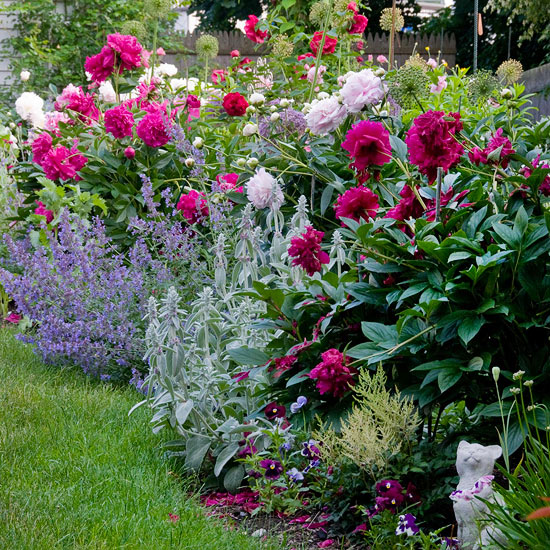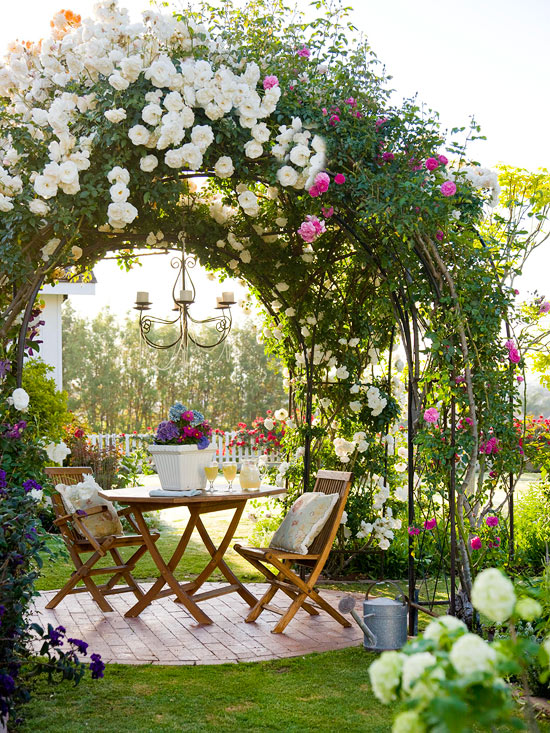





The exuberance of a full-fledged cottage garden always enchants. Curving pathways lead to abundant flowerbeds. A relaxed atmosphere prevails. Often, a picket fence functions less as a corral and more as a beautiful prop to showcase the plants. Although Mother Nature rarely creates spaces quite this gorgeous, a cottage-style landscape appears perfectly natural. The overall effect is one of simplicity, charm, and riotous bounty.
A cottage-style garden may appear to be naturally crafted and slightly out of control, but in fact, it follows a few simple rules. Use these landscape design ideas to create a look that will make any home seem like a sweet cottage.
continue reading below
Cottage-style landscape design is relaxed and loose, not rigid or formal. To enhance the air of informality, curve the pathways and flowerbed edges. Curves entice the visitor to move farther into the garden to see what is around the bend and discover the mysteries hidden inside. Encourage plants to drape over the edges of the beds, softening the lines.
Cottage gardens originated in Europe where peasants grew their favorite plants -- beautiful as well as practical -- in small spaces. For your cottage garden, always select plants that grow easily in your area. Growing plants from cuttings or divisions that originated with friends and family keeps with the spirit of cottage gardens.
Learn how to divide perennials.
Place plants as close together as you can without causing them to smother each other. This style of planting has the benefit of crowding out weeds. Add compost each year so the soil has enough nutrients to support a large plant population. To help with weed control and moisture retention, mulch the beds with organic material that breaks down and adds nutrients to the soil.
Get tips for making your own compost!
Avoid placing plants in regimented lines or patterns; cottage-style landscape design relies on plants appearing to tumble about with abandon.

A cottage garden should express both joy and purpose. The original cottage-style landscape designs placed beautiful bloomers of varying heights right next to native plants, herbs, and ornamental vegetables.
Color schemes follow no rules, varying from a soothing pastel plan of pinks, blues, and yellows to an intense riot of reds, oranges, purples, silvers, and more.
Plants with multiple petals, such as roses and peonies, are cottage-style favorites, and they have the added benefit of sweet scent. Contrast heights within beds by using spiky classics such as foxgloves and delphiniums.
Pick a perfect peony.
Find the easiest roses to grow.
Annuals, with their constant blooming ways, are perfect for cottage beds. Consider varieties of zinnia, moss rose, marigold, salvia, and nasturtium for ease of care. Verbena bonariensis, with its airy habit, fits anywhere and has the added benefit of being a prolific reseeder.
Rely on perennials with a long season of interest or texture, such as fuzzy lamb's-ears, hardy geranium, lady's mantle, and sedums, to carry from one year to the next.
See our 18 best plants for a cottage garden.
Incorporate shrubs or small trees. A panicle hydrangea, Japanese maple, or ornamental dwarf conifer adds dimension and year-round "bones" to the beds.
Avoid going too far afield with exotics or high-maintenance plants. Tropical plants look interesting and perform well in many areas, but they don't particularly fit the cottage style.
Most blooming plants rely on full or partial sun to perform well. If you want to grow a cottage garden in a shady location, you may need to tone down your expectations of possible color schemes. Don't despair; plenty of fine shade plants will give plenty of the texture and informal grace you desire.
Discover shade-garden design secrets.

Even if you don't have a thatched roof, you can give your home a romantic attitude with the right props. A low fence, such as a classic white picket or wrought-iron fence, offers a sense of enclosure and heightened style.
Add a vine- or rose-covered matching arbor or trellis to connect unrelated areas, such as a front yard to a backyard.
Connect your gardens with stylish gates.
Find stylish pergola ideas.
To create vertical interest, place an obelisk or tuteur inside a flat expanse. If you have a large garden, space these structures along alternate sides of a pathway so they appear to draw you along.
Relax in outdoor furniture that looks homey and comfortable, not tired and rundown. Country-style painted and weathered wood chairs, antique metal shellback chairs, or a cute bistro set work well in the design scheme.
See how cottage design elements work in the garden.
Decorate your landscape with beloved items that carry emotional value and a patina of age, such as the lightning rods from your grandfather's farm or the rusty little wagon your mother always used. Don't overdo; a few ornaments placed properly can go a long way.
A cottage-style landscape should feel good to you, not like a burden. Don't feel like it has to look like a magazine spread. Choose what you love, and the beauty will follow.
Get romantic cottage-style garden plans.
Explore a colorful cottage garden.
Copyright © www.100flowers.win Botanic Garden All Rights Reserved